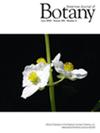Importance of habit and environmental characteristics in shaping patterns of richness and range size of ferns and lycophytes in the Atlantic Forest
Abstract
Premise
Ferns and lycophytes, the two spore-bearing lineages of vascular plants, share a unique life cycle, and because of several morpho-ecophysiological similarities, are usually investigated as a unit, but they may have distinct ecological and environmental responses. Understanding the diversity and distribution patterns of ferns and lycophytes separately is essential for designing effective conservation strategies.
Methods
We assessed species richness and range sizes using range–diversity analyses and investigated environmental (climatic, edaphic) and ecological (endemism, habit diversity, specialization) predictors of these range and richness metrics using generalized linear models.
Results
The central region of the Atlantic Forest primarily contained areas with fern and lycophyte species with high richness and small ranges; the northern and southern extremes of the forest had species with low richness and larger ranges. Fern richness was associated with a combination of environmental and ecological variables; lycophyte richness was associated only with ecological variables. Range sizes were positively related to habit diversity for both ferns and lycophytes, but the effect of environmental variables differed between the two lineages. Critical areas were primarily not within protected areas.
Conclusions
Fern range sizes and richness were influenced by a combination of ecological and environmental factors such as temperature, precipitation, and soil variables; only ecological variables influenced lycophyte richness and range sizes. The effects of these factors must be considered separately for the two lineages due to their different responses to stressors. Conservation efforts should increase in the species-rich–low-range areas that are outside protected areas to protect these low-range species.

 求助内容:
求助内容: 应助结果提醒方式:
应助结果提醒方式:


